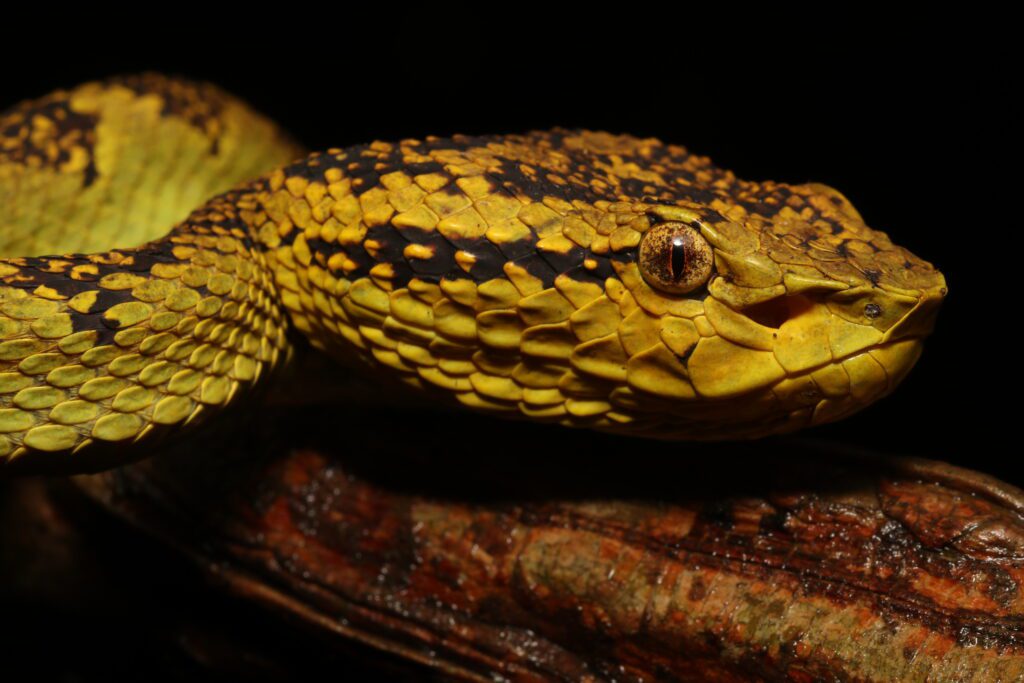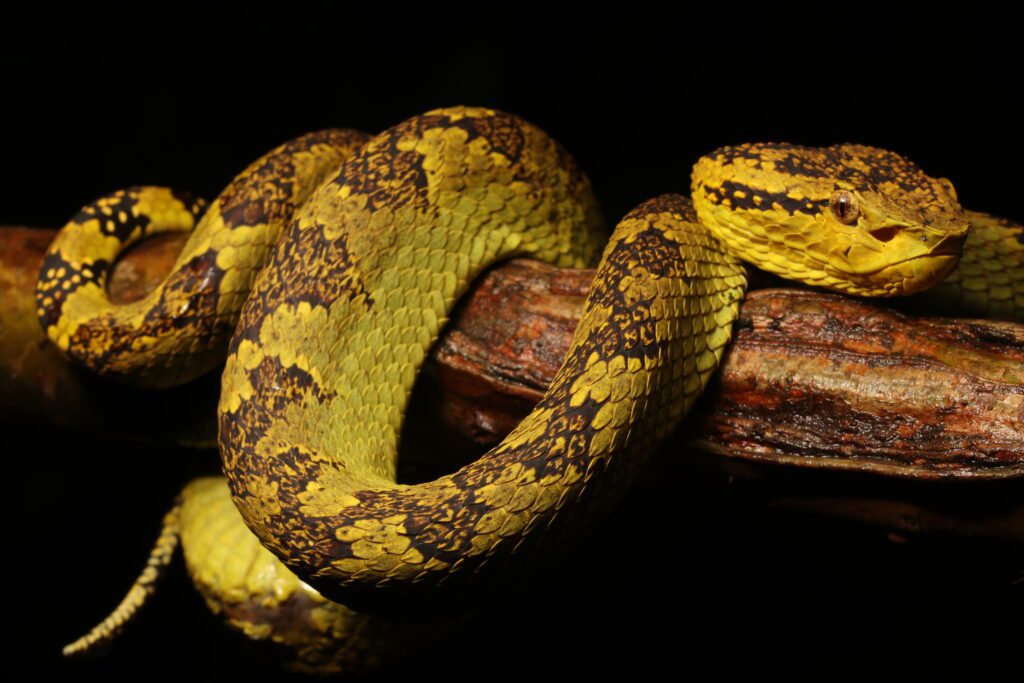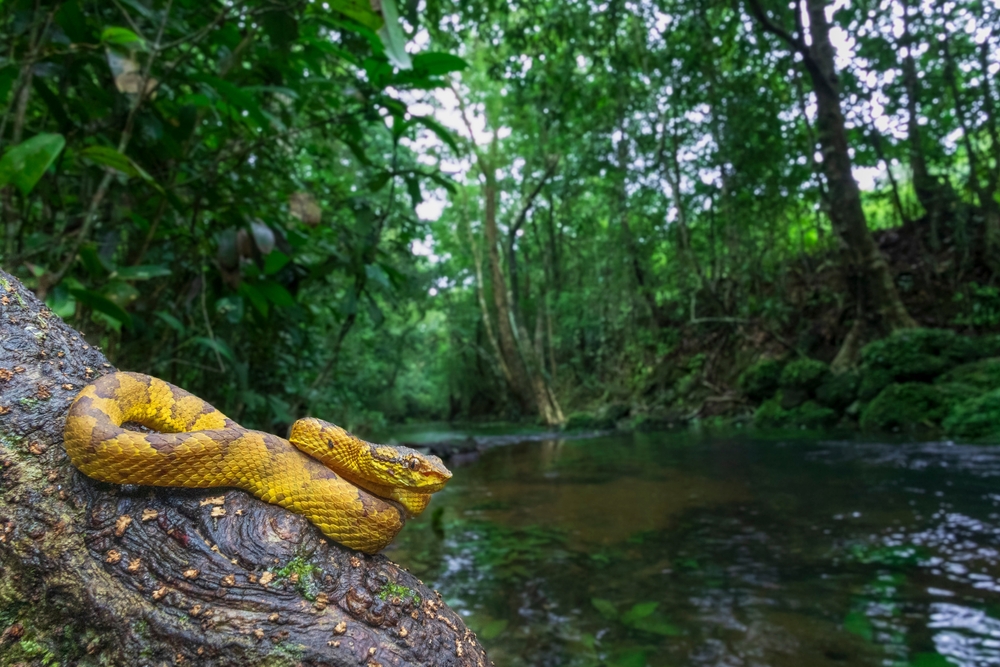The Malabar pit viper (Peltopelar malabaricus) is a reasonably large, arboreal Viperid from the Western Ghats Mountain Range in India. Although it is endemic to this region, the Western Ghats stretch for around 1600km and cover 6% of India, making the Malabar pit viper a reasonably widespread species. Despite this, little is known about the spatial ecology of this cryptic reptile. Whilst they are often sighted during the monsoon seasons, they seemingly disappear with the rains. Researchers at the Kalinga Foundation helping to uncover this mystery by using radio telemetry devices to track these mysterious serpents.


The Malabar Pit Viper
The Malabar pit viper is a highly variable species that grows to around 100cm in length. Like most arboreal pit vipers, females are significantly larger than males. These snakes can be found in riparian, evergreen and deciduous forests from 600 to 200m above sea level. They will also inhabit forests close to plantations and on the edges of farmland. However, they are perhaps most commonly seen close to streams and torrents where they actively feed on frogs, especially during monsoon season. They are ambush predators and if left undisturbed, can remain in ambush position for several days at a time.
Malabar pit vipers are perhaps best known for being incredibly variable. Within the same population, it is possible to find brown, bright yellow, green, orange and even blue individuals. Of these base colours, pattern combinations can lead to some animals having a purple or brick-red appearance. Typically, females are brighter and bulkier than males. In fact, it is possible that all bright yellow and green Malabar pit vipers are female while the drabber brown or orange animals are male. Individual snakes often change their appearance as they mature too, with certain colours and patterns developing over time.
The Malabar pit viper has undergone various taxonomic revisions in recent years and was split into a species “complex” in 2023. It was originally broken into three species, but only one currently stands, P. anamallensis which is only found in the southern Western Ghats in the state of Kerala. Even the genus of Peltopelar malabaricus is regularly updated, making scientific names somewhat difficult to follow.


Researching Malabar Pit Vipers
Priyanka Swamy has centred her PhD research around the Malabar pit viper for several years, actively tracking the snakes with radio telemetry devices since 2022. “When you deploy a radio transmitter and track a snake over time, you learn their habitat usage, preferences and range” explains Priyanka. “This tells us how much human-inhabited space they are likely to be in and how often within a season they are likely to encounter a human.”
“Malabar pit vipers are a medically important species in India. Whilst everyone is focusing heavily on “the big four” responsible for most deaths, we wanted to look at the species responsible for the mostsnakebites in this region.”
India has the highest number of fatalities due to snakebites in the world. An estimated 58,000 people are killed by snake envenoming in India each year. The World Health Organization have called to halve snakebites around the world by 2030. They write: “We analyzed 2833 snakebite deaths from 611,483 verbal autopsies in the nationally representative Indian Million Death Study from 2001 to 2014 and conducted a systematic literature review from 2000 to 2019 covering 87,590 snakebites. We estimate that India had 1.2 million snakebite deaths (average 58,000/year) from 2000 to 2019. Nearly half occurred at ages 30–69 years and over a quarter in children < 15 years. Most occurred at home in the rural areas. About 70% occurred in eight higher burden states and half during the rainy season and at low altitude. The risk of an Indian dying from snakebite before age 70 is about 1 in 250, but notably higher in some areas. More crudely, we estimate 1.11–1.77 million bites in 2015, of which 70% showed symptoms of envenomation. Prevention and treatment strategies might substantially reduce snakebite mortality in India.”
Priyanka continued: “Of all the pit viper species in the Western Ghats, the Malabar pit viper has the largest range so more people encounter that species than any other pit viper. Because we are working in a heterogenous habitat it gives us a gradient of understanding pit vipers in forest habitat as well as close to human inhabitation. Eventually, we hope this will help in conflict mitigation. We can tell people ‘they prefer this habitat in this season, so be careful at this time of year.”
Priyanka’s research is also helping to understand more about the general conservation status of Malabar pit vipers. This sparked Priyanka’s curiosity as she embarked on a mission to understand more about the habitat usage and ecology of these vipers.
She continued: “Even though the Malabar pit viper is encountered the most of all the vipers of the Western Ghats, it is data-deficient from a conservation perspective. We have documented close to 200 pit vipers in a 4-acre area of rainforest here at the Kalinga Foundation field station. This gives us a good idea of the population size in this location. However, across the Western Ghats, a lot of habitat destruction has occurred such as building dams, clearing forests for agricultural purpose or logging. If a small space can be occupied by such a strong population of this endemic species, just imagine what the entire Western Ghats holds. This model can be used in other places so that we can learn more about the entire population.”

How Do You Track a Snake?
Priyanka and the team at the Kalinga Foundation monitor the movements of pit vipers each year using tracking equipment. Small transmitters are surgically implanted into snakes by a veterinarian during the dry season. The trackers/transmitters can then be located with a radio telemetry antenna and receiver device that tells the researchers how close the snake is.
Radio transmitters are inserted into the coelomic cavity and the antennae is run laterally between the subcutaneous tissue and the peritoneum. To ensure all the surgeries are consistent and ethical, the team follow the methodology of Reinert and Cundall (1982) and Hardy and Greene (2000).
Snakes large enough to be implanted with BD-2 (1.4 g) and PD-2 (2.5 and 3 gm) radio transmitter will be selected for the study. Following surgery, we will keep the snakes under observation until they become fully responsive. Snakes are released back at the site of capture at night as pit vipers are nocturnal in nature (based on preliminary observations).
Priyanka explains: “When we think about snakes, we often consider a two-dimensional area of utilization. These vipers use vertical space as well. That makes it extra interesting for us.”
“We deploy the transmitters before monsoon season. So, it was difficult in 2022 when we first started because we were not finding many pit vipers at all. Once the monsoons start, the females start to come down. We track them throughout the year, but after the monsoons stop they might not come down from the canopy for months. It is easy to lose a tracker if a snake doesn’t return for months, we’ve even tracked a Malabar pit viper that moved shockingly far through the forest and found that it had been eaten by a King Cobra.”
Already, the team at Kalinga Foundation are discovering interesting patterns in the habitat usage of Malabar pit vipers. Both male and female specimens are tracked throughout the year. By understanding the spatial ecology of each sex, Priyanka can theorise the environmental cues that prompt breeding behaviour, understand more about the species courtship and even pick apart potential differences in diet between the sexes. However, with females being over double the size of males, different techniques are required.
“The maximum size transmitter we can deploy is 5g” added Priyanka. “This would be for the largest females that usually weigh 130g. These transmitters can last up to seven months. The smallest transmitter we deploy is about 1.7g which lasts about one and a half to two months. During summer time it’s quite easy to track them, but during monsoon seasons when your vision is compromised by heavy rains and you’re sharing space with leopards and gaur and other venomous snakes, it can be challenging to track them.”
Arboreal pit vipers are often considered sedentary reptiles. They can remain in the same ambush position for many weeks at a time if undisturbed. Some pit vipers in Latin America have been reported in the same position for over three months. Whilst these animals may have moved and returned with frequency to an exact location, the hunting practices of arboreal pit vipers naturally make them less mobile than elapids or colubrids that actively seek out prey. However, the team frequently record Malabar pit vipers moving up to 100ft a night.
Future Research
Radio telemetry research can provide scientists with huge amounts of valuable data. However, it is not without its challenges. “The method we are using is very well established in Southeast Asian countries, but in India it’s rarely used” added Priyanka. “Perhaps this is because of affordability. Tracking devices are extremely expensive. The medical procedure to install them must also be done by a veterinarian. All of this requires funding.”
The Kalinga Foundation field station is an important space for scientific research and broader education. The research station-turned-ecolodge is open to members of the public and ecotourists who can learn about native herpetofauna whilst being hosted. The funding from this then helps keep the station financially viable while researchers, students and local communities visit or study at the field station. The site, which was opened by world-renowned herpetologists Dr P Gowri Shankar and managed by Prashanth P in 2013 also plays host to several snake rescuers, who will actively remove potentially dangerous snakes from local homes, helping to support the already positive cultural relationship between people and cobras in the Agumbe region.